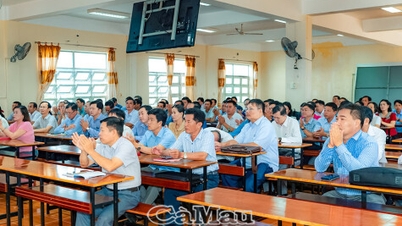The Ministry of Education and Training said that teachers' salaries are being paid according to the Government 's regulations in Decree 204/2004/ND-CP and are applied according to the Professional and Technical Salary Table for cadres and civil servants in State-owned enterprises, with starting salaries corresponding to the regulations on training levels (type B for intermediate level, type A0 for college level, types A1, A2, A3 for university level and above).
In addition to salary, teachers are also entitled to a number of allowances including: Seniority allowance for teachers; preferential allowances according to the profession for teachers directly teaching at all levels, subjects, teaching objects and working regions with levels from 25-70%,...
Salary, allowance and incentive policies are still inadequate.
However, according to the Ministry of Education and Training, the implementation of salary policies, allowances, and preferential policies for teachers still has some shortcomings.
Firstly, the policy of teachers' salaries being given the highest priority in the administrative career salary scale has not been implemented.
Specifically, the salary scale applied to civil servants in general includes 10 salary scales arranged from low to high, respectively C1, C2, C3, B, A0, A1, A2.2, A2.1, A3.2, A3.1 (with levels from 1 to 12, the number of levels depends on the type of civil servant).
However, the current salary classification for teaching positions is that only 3 positions are subject to the salary of A3 type officials (including A3.2 and A3.1 - the 2 highest salary scales), which are senior university lecturers (including professors and associate professors), senior vocational education lecturers, and senior vocational education teachers; accounting for about 1.17% of the total number of teachers. Meanwhile, in other sectors and fields, about 10% of officials are subject to the salary of A3 type officials.
Meanwhile, according to the Ministry of Education and Training, the tasks of all first-class civil servants in general are similar to those of senior teachers (first-class), which are to develop documents and guide lower-class civil servants; act as judges, set questions or give instructions at competitions and contests; be a pioneer group in developing and implementing innovation directions for the industry... and especially do not require policy-making tasks like civil servants.
The salaries of most teachers (except college and university lecturers and vocational education teachers) are lower than those of civil servants in other sectors such as healthcare (doctors, pharmacists), construction (architects, accountants), transportation (road technicians, managers, construction maintenance, etc.), justice (criminal records officers, etc.), culture and sports (directors, actors, artists, coaches, etc.), science and technology (researchers, engineers), and information and communication (reporters, translators, television directors).
Civil servants in other sectors are classified into 3-4 ranks (from rank IV to rank I), receiving salaries from A1-A2.1-A3.1 (corresponding to the salary scale 6-8-10). Except for university and college lecturers and vocational education teachers, teachers are also classified into 3-4 ranks (from rank IV to rank I), most of whom are receiving salaries from A0-A1-A2.2-A2.1 (corresponding to the salary scale 5-6-7-8) and are preschool, general education, university preparatory, and continuing education teachers (accounting for about 88% of the total number of teachers).
In addition, Point c, Clause 1, Article 23 of the Law on Teachers stipulates that “preschool teachers… are entitled to a higher salary and allowance regime than teachers working under normal conditions”. However, currently, preschool teachers’ salaries are ranked lowest compared to other teaching positions (A0-A1-A2) and almost lowest compared to civil servants in other sectors and fields.

The Ministry of Education and Training also pointed out the shortcomings in designing the salary table for civil servants. The Ministry believes that the salary regulations are applied to all civil servants in all sectors/fields, leading to the failure to reflect the complexity of each different sector and profession.
The difference in salary coefficients between the salary tables of civil servants is not similar, there are salary tables with too little difference between the starting salary coefficients, or there are salary tables with quite a large gap between the starting salary coefficients. For example, the difference in starting salary coefficients between A0 (2.10) and A1 (2.34) and between A2.2 (4.0) and A2.1 (4.4) is very small. This does not create motivation for teachers to study to improve their professional qualifications, skills and career advancement.
According to the Ministry of Education and Training, in reality, the current salary payment method is based on the appointed position - training level - seniority.
The salary gap between newly qualified teachers and experienced teachers is large (higher coefficient, higher seniority allowance, and preferential allowances are equal but calculated based on salary coefficient, so the gap is even larger) while performing basically the same tasks.
The number of teachers quitting their jobs is on the rise.
The Ministry of Education and Training also said that the shortage of teachers is still occurring in many localities (especially preschool teachers and primary school teachers in public educational institutions) due to the rapid increase in the number of students while localities have to streamline the payroll according to regulations. At the same time, there is a shortage of teachers in some subjects such as information technology, foreign languages, and arts due to a lack of recruitment sources, because those who study these majors have the opportunity to find jobs in other professions with higher incomes than becoming teachers; or a shortage of teachers working in schools in ethnic minority areas, mountainous areas, border areas, islands and areas with especially difficult socio-economic conditions...

As of April 2025, the whole country still lacks 102,097 teachers at all levels of preschool and general education in the payroll compared to the prescribed norms of the Ministry of Education and Training (of which preschool lacks 30,057, primary school lacks 22,255, secondary school lacks 30,702, high school lacks 19,083).
In addition, according to statistics from the Ministry of Education and Training in the 3 school years, from August 2020 to August 2023, the whole country had over 40,000 teachers quitting or changing jobs; teachers under 35 years old quitting their jobs accounted for 60% of the total number of quitting their jobs. From August 2023 to April 2024, 7,215 teachers quit their jobs, of which the number of teachers quitting their jobs at preschool level accounted for a high proportion (about 1,600 teachers, accounting for about 22%) and gradually decreased according to the levels of education from low to high.
Teachers enjoy preferential allowances depending on their profession from 25% to 70%, of which most teachers only enjoy allowances of 25% - 35% (about 76%) - mainly concentrated in the plains and cities where the standard of living is higher than other regions; higher levels only apply to special cases.
In addition, in the first 5 years of work, new teachers only receive salaries based on salary coefficients and preferential allowances, without seniority allowances, so their total income is still low, so there is a large gap compared to experienced teachers even though their basic tasks are the same. Specifically, the lowest salary of preschool teachers is about 6.6 million, primary school teachers is about 7.3 million, middle school, high school and university preparatory teachers is about 7.1 million; there is a huge gap compared to the highest salaries of teachers, which are 20.6 million, 24.6 million, 28.5 million and 30.5 million respectively; lower than the average salary of 7.7 million of workers in 2024.
Income that is not enough to live on is also part of the reason why the number of teachers quitting their jobs has increased in recent years, especially among young teachers under 35 years old.
According to the Ministry of Education and Training, the issuance of a Decree regulating salary policies and allowances for teachers is necessary to overcome existing shortcomings, ensure stable quantity, and improve the quality of the teaching staff.
Source: https://vietnamnet.vn/bo-gd-dt-neu-nhung-ly-do-can-phai-them-luong-dac-thu-cho-giao-vien-2458683.html


![[Photo] Ca Mau "struggling" to cope with the highest tide of the year, forecast to exceed alert level 3](https://vphoto.vietnam.vn/thumb/1200x675/vietnam/resource/IMAGE/2025/11/04/1762235371445_ndo_br_trieu-cuong-2-6486-jpg.webp)

![[Photo] Ho Chi Minh City Youth Take Action for a Cleaner Environment](https://vphoto.vietnam.vn/thumb/1200x675/vietnam/resource/IMAGE/2025/11/04/1762233574890_550816358-1108586934787014-6430522970717297480-n-1-jpg.webp)
![[Photo] Panorama of the Patriotic Emulation Congress of Nhan Dan Newspaper for the period 2025-2030](https://vphoto.vietnam.vn/thumb/1200x675/vietnam/resource/IMAGE/2025/11/04/1762252775462_ndo_br_dhthiduayeuncbaond-6125-jpg.webp)

![[Photo] The road connecting Dong Nai with Ho Chi Minh City is still unfinished after 5 years of construction.](https://vphoto.vietnam.vn/thumb/1200x675/vietnam/resource/IMAGE/2025/11/04/1762241675985_ndo_br_dji-20251104104418-0635-d-resize-1295-jpg.webp)


































































































Comment (0)